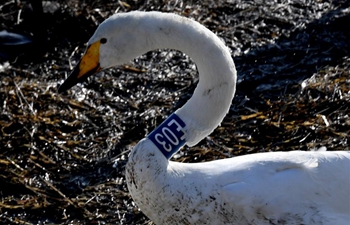SYDNEY, Nov. 29 (Xinhua) -- Scientists have great concerns for the future survival of Australia's unique aquatic creature, the platypus, with the close of a three-year national survey highlighting evidence that population figures are falling faster than anticipated.
A project led by the University of New South Wales (UNSW) conducted a national risk assessment for the species by combining a comprehensive database of platypus numbers from the past two centuries with data from modern systematic capture surveys.
"The national risk assessment has suggested declines of up to 30 percent across its range since European settlement, with localized declines and extinctions increasingly reported," director of the UNSW Centre for Ecosystem Science and project leader Professor Richard Kingsford said on Thursday.
"Synergistic threats to platypus population include river regulation and flow disruption, increasing agricultural land use, pollution, and the capture of platypus in fishing and yabby nets, all of which are contributing to these declines across its range" the professor said.
Despite the glum news, researchers are hoping that by establishing the national survey with the inclusion of historical data, it is likely to lead to much more effective conservation actions.
"Previously we've had no information on historical platypus abundances and without this baseline reference we become misinformed about what a normal abundance is," Ph.D. candidate Tahneal Hawke at UNSW who worked on the project explained.
"This shift in our perception is particularly important for such a cryptic animal, " the Ph.D. candidate said.
"Given sightings are rare, people perceive captures or sightings of just a few platypuses to be indicative of a healthy population, while historical records suggest numbers far exceeded our current observations," the Ph.D. candidate added.
Researchers are expected to publish the full risk assessment for the species in the early part of 2019.













